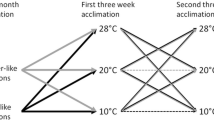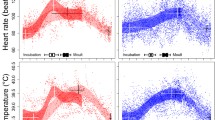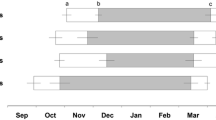Summary
Physiological limits to energy budgets were estimated in Djungarian hamsters (Phodopus sungorus) using food balance and respirometric methods. The summer acclimatized, reproductively inactive hamsters could balance their energy budget at-2° C, assimilating 91.1 kJ·animal-1· day-1 after gradual cold acclimation, whereas non-acclimated hamsters showed negative energy balance assimilating only 54.4 kJ·animal-1·day-1. At the same ambient temperature, multiparous females (although neither pregnant nor lactating at the time) maintained positive energy balance assimilating 81.6 kJ·animal-1·day-1. Hamsters are capable of rapid adjustments of their maximum assimilation rates to meet their current energy demands, but only up to the value of about 3.5xBMR. It is concluded, that the actual energy budgets of small mammals keep, all the time, fairly near the upper physiological limit, with body reserves ready to buffer short-term oscillations.
Similar content being viewed by others
References
Barnett SA (1973) Maternal processes in the cold-adaptation of mice. Biol Rev 48:477–508
Calow P (1984) Economics of ontogeny — adaptational aspects. In: Shorrocks B (ed) Evolutionary ecology. Blackwell, Oxford
Caswell H (1982) Optimal life histories and the age-specific costs of reproduction. J theor Biol 98:519–529
Drożdż A (1975) Food habits and food assimilation in mammals. In: Grodziński W, Klekowski RZ, Duncan A (eds) Methods for ecological bioenergetics. Blackwell, Oxford
Edwards AL (1985) Multiple regression and the analysis of variance and covariance. Freeman, New York
Figala J, Hoffman K, Goldau G (1973) Zur Jahresperiodik beim Dsungarischen Zwerghamster Phodopus sungorus Pallas. Oecologia (Berlin) 12:89–118
Fleming TH (1979) Life-history strategies. In: Stoddart DM (ed) Ecology of small mammals. Chapman and Hall, London
Gebczynska Z, Gebczyński M (1981) Length and weight of the alimentary tract of the root vole. Acta theriol 16:359–369
Grodziński W, Makomaska M, Tertil R, Weiner J (1977) Bioenergetics and total impact of vole populations. Oikos 29:494–519
Grodziński W, Wunder B (1975) Ecological energetics of small mammals. In: Golley FB, Petrusewicz K, Ryszkowski L (eds) Small mammals: their productivity and population dynamics. Cambridge University Press, London
Gross JE, Wang W, Wunder BA (1985) Effects of food quality and energy needs: changes in gut morphology and capacity of Microtus ochrogaster. J Mammal 66:661–667
Heldmaier G (1975) Metabolic and thermoregulatory responses to heat and cold in the Djungarian hamster, Phodopus sungorus. J Comp Physiol 102:115–122
Heldmaier G, Steinlechner S (1981) Seasonal control of energy requirements for thermoregulation in the Djungarian hamster (Phodopus sungorus). living in natural photoperiod. J Comp Physiol 142:429–437
Heldmaier G, Steinlechner S, Rafael J (1982) Nonshivering thermogenesis and cold resistance during seasonal acclimatization in the Djungarian hamster. J Comp Physiol 149:1–9
Jagosz J, Górecki A, Pozzi-Cabaj M (1979) The bioenergetics of deposit and utilization of stored energy in the common vole. Acta Theriol 24:391–397
Karasov WH (1981) Daily energy expenditure and the cost of activity in a free-living mammal. Oecologia (Berlin) 51:253–259
Kendeigh SC (1974) Seasonal allocation of time and energy resources in birds. In: Paynter RA Jr (ed) Avian energetics. Nuttal Ornith Club Publ 15, Cambridge (Mass)
King JR, Murphy ME (1985) Periods of nutritional stress in the annual cycles of endotherms: fact or fiction? Am Zool 25:955–964
Kirkwood JK (1983) A limit to metabolizable energy intake in mammals and birds. Comp Biochem Physiol 75A:1–3
Kleiber M (1961) The fire of life. Wiley, New York
Kozowski J, Wiegert RG (1986) Optimal allocation of energy to growth and reproduction. Theor Pop Biol 21:16–37
Le Magnen J, Devos M (1982) Daily body energy balance in rats. Physiol Behav 29:807–811
McNab BK (1980) Food habits, energetics, and the population biology of mammals. Am Nat 116:106–124
Millar JS (1984) The role of design constraints in the evolution of mammalian reproductive rates. Acta Zool Fennica 171:133–136
Myrcha A (1964) Variations in the length and weight of the alimentary tract of Clethrionomys glareolus (Schreber, 1780). Acta Theriol 9:139–148
Myrcha A (1965) Length and weight of the alimentary tract of Apodemus flavicollis (Melchior, 1834). Acta Theriol 10:225–228
Nagy KA, Seymour RS, Lee AK, Brathwaite R (1978) Energy and water budgets in free-living Antechinus stuartii (Marsupialia: Dasyuridae). J Mammal 59:60–68
Oftedal OT (1984) Milk composition, milk yield and energy output at peak lactation: a comparative review. In: Peaker M, Vernon RG, Knight CH (eds) Physiological strategies in lactation. Symp Zool Soc London, Academic Press, London
Piatkowska M, Weiner J (1987) Maximum rate of energy assimilation in the bank vole (Clethrionomys glareolus) Acta Theriol (in press)
Pond CM (1981) Storage. In: Townsend CR, Calow P (eds) Physiological ecology, Blackwell, Oxford
Prus T (1975) Measurement of calorific value using Phillipson microbomb calorimeter. In: Grodziński W, Klekowski RZ, Duncan A (eds) Methods for ecological bioenergetics. Blackwell, Oxford
Sibly RM (1981) Strategies in digestion and defecation. In: Townsend CR, Calow P (eds) Thysiological ecology, Blackwell, Oxford
Schierwater B, Klingel H (1985) Food digestibility and water requirements in the Djungarian hamster Phodopus sungorus. Z Säugetierkunde 50:35–39
Sokal RR, Rohlf FJ (1981) Biometry. Freeman, San Francisco
Stearns SC (1976) Life-history tactics: a review of the ideas. Quart Rev Biol 51:3–47
Townsend CR, Calow P (1981) Physiological ecology. An evolutionary approach to resource use. Blackwell, Oxford
Weiner J (in press) Limits to energy budget and tactics in energy investments during reproduction in the Djungarian hamster (Phodopus sungorus sungorus). In: Loudon A, Racey PA (eds) Reproductive energetics in mammals. Academic Press, London
Weiner J, Górecki A (1981) Standard metabolic rate and thermoregulation in five species of Mongolian small mammals. J Comp Physiol 145:127–132
Weiner J, Górecki A (1982) Small mammals and their habitats in the arid steppe of Central Eastern Mongolia. Pol Ecol Stud 8:7–21
Wunder BA (1985) Energetics and thermoregulation. In: Tamarin RH (ed) Biology of New World Microtus Spec Publ No 8 Am Soc Mammal, Boston
Author information
Authors and Affiliations
Rights and permissions
About this article
Cite this article
Weiner, J. Maximum energy assimilation rates in the Djungarian hamster (Phodopus sungorus). Oecologia 72, 297–302 (1987). https://doi.org/10.1007/BF00379282
Received:
Issue Date:
DOI: https://doi.org/10.1007/BF00379282




